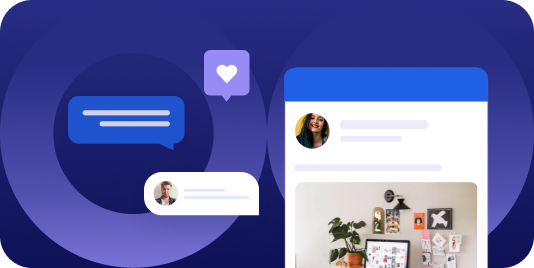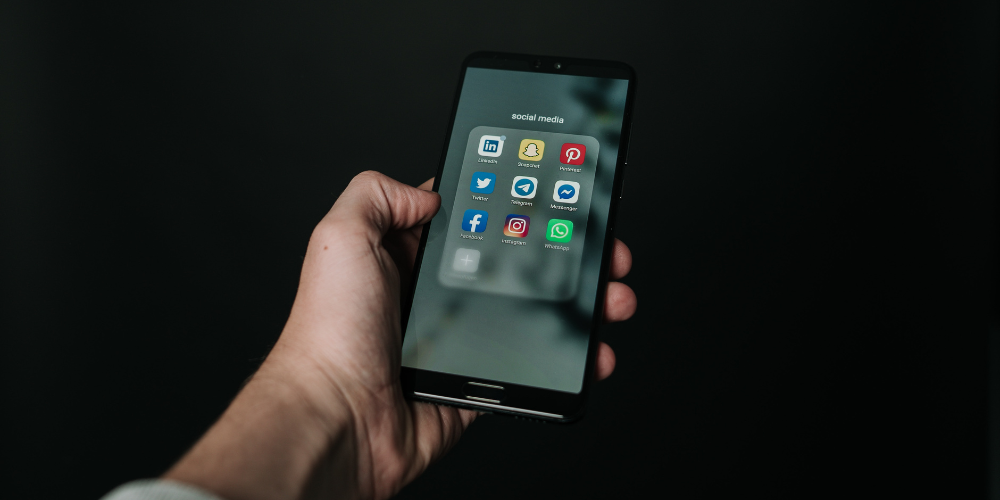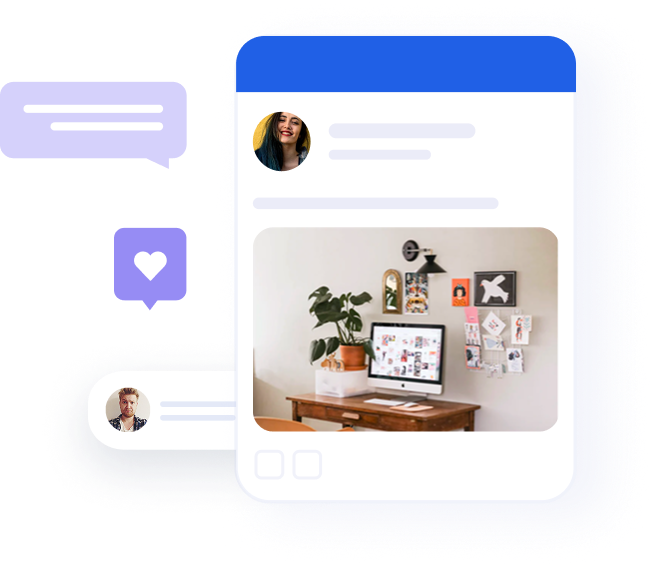EGC vs. UGC: which drives more impact in B2B marketing?

Table of contents
- What is user-generated content (UGC)?
- What is employee-generated content (EGC)?
- Benefits of UGC in B2B marketing
- Benefits of EGC in B2B marketing
- Harnessing UGC without losing control
- From non socially active employees to brand champions: overcoming EGC hurdles
- Streamlining EGC production with Oktopost
- How to integrate UGC and EGC for maximum impact
- Examples of successful UGC and EGC campaigns in B2B
- Turn authentic connections into B2B marketing success with UGC & EGC
There’s plenty of debate about the future of B2B marketing, but one thing is clear: social media algorithms prioritize personal accounts over corporate accounts. We’re in an era where authentic voices drive engagement, making User-Generated Content (UGC) and Employee-Generated Content (EGC) essential to B2B brand marketing and communication strategies. Influencers with industry expertise and a dedicated following are playing a key role in this shift, sparking meaningful conversations and shaping brand perception through their insights.
Together, these strategies make for a powerful duo, offering audiences a transparent view from the outside (UGC) and the inside (EGC), defined by individual, personal voices of professional influencers they know and trust.
This article explains UGC and EGC, explores their unique benefits in B2B marketing, and shares best practices for integrating both into a cohesive social media marketing strategy. We’ll also highlight real-world examples of brands using UGC and EGC to drive engagement, build credibility, and boost their conversion rate.
What is user-generated content (UGC)?
There are many types of user-generated content (UGC): reviews, photos, videos, or any content created by customers on social media platforms. You can think of UGC as digital word of mouth. It’s what happens when a customer posts a LinkedIn post about your software and how it’s made their workflow easier. It is what happens when a product user shares their experience of working with your technical support team and how it helped them figure out a complex problem on time.
A post like that can impact your brand confidence, your brand’s value, and ultimately, purchasing decisions, motivating buyers to shortlist your solution or take the next step and click that demo booking form. In a space where most of your audience is overexposed to branded content, UGC can break through the cycle of corporate messaging with an authentic and sincere human voice.
What is employee-generated content (EGC)?
Like UGC, Employee-Generated Content (EGC) is content that people make in their own capacity, this time as employees. This kind of content offers a behind-the-scenes look at a brand. It could be an Instagram Story of a fun office event, a LinkedIn post about a career milestone, or a day-in-the-life video from a team member. Common and impactful employee-generated posts include information about them participating in a physical business event, inviting their connections and followers to meet them at their company booth or meeting room, and connecting online and offline communications with customers and prospects.
Employee advocacy posts can do wonders for engagement on social media because they reinforce the positive claims that a company makes about itself. Every company’s corporate messaging talks about a great team culture and innovative approach, but people are far more likely to believe it if they see it coming from employees and not just the CEO or the recruitment team. And because employees’ social networks are, on average, over five times larger than their company’s official accounts, every EGC post is an opportunity for a massive increase in reach, free of charge.
Recommended for further reading
Benefits of UGC in B2B marketing
When satisfied customers talk about your product or service, they introduce it to their professional networks with a powerful dose of social proof. A single testimonial can expose your brand to new audiences who trust the source. Reaching those new audiences would have been costly through regular paid advertising, but an effective UGC campaign sidesteps the cost and brings the brand immediate value.
It’s organic, credible, and far more persuasive than a brand-led message. Once UGC gains traction, it creates a ripple effect that expands visibility, sparks conversations, and builds trust, all without additional marketing spend. This is especially relevant for younger audience segments like Gen Z, who expect real, people-first engagement from brands. When someone advocates for another person who works for your company, it resonates more than a corporate post highlighting a corporate case study.
Benefits of EGC in B2B marketing
Employee-generated content (EGC) offers a unique blend of authenticity and reach that traditional corporate messaging often lacks.
Here are three key benefits of integrating EGC into your marketing mix:
- More engagement: When employees create and share content, it tends to generate significantly higher engagement and reach compared to brand-owned channels. By equipping employees to share their experiences, businesses can tap into their networks and drive meaningful interactions.
- Better brand reputation: EGC allows employees to share authentic insights about their work, projects, and company culture. This transparency positions a brand as genuine and sincere.
- Enhanced recruitment efforts: Job seekers pay attention to what your employees say, making EGC impactful for a healthy employer brand. Done right, it can dramatically improve a company’s ability to attract top talent.
Harnessing UGC without losing control
Because there are so many people who can create UGC, it can be challenging to monitor or assess quality. For some people , it’s a matter of shooting a quick 30-second video with a smartphone. Others might take more care to create a detailed, high-quality post. In both cases, the business can have very little influence. Setting clear guidelines and encouraging specific themes helps steer this content in the right direction. Encouraging customers, contacts, and users to share their thoughts and experiences on social media is a good start.
It’s also important to remember that not all UGC is positive. While transparency is valuable, businesses must respond to such content effectively. Actively monitoring and engaging with all feedback helps turn these challenges into trust-building moments. User-generated content can sometimes include negative comments or controversial comments, and both are an opportunity for engagement and discussion.
Legal considerations also play a role. Just because a customer tags your brand doesn’t mean you have the right to use their content. Always obtain proper permissions and be aware of copyright laws before repurposing UGC to avoid potential misunderstandings or legal issues.
From non socially active employees to brand champions: overcoming EGC hurdles
Encouraging employees to start discussing their work life isn’t always easy. They may feel uncomfortable sharing publicly or doubt their content’s value. They may also simply not want to create content at all. It can be seen as additional work above their already challenging workload. Without understanding the importance of their personal brand and what is in it for them, even with the right incentives or company culture, participation might be minimal. Identify the customer-facing employees who are aware of the importance of being active on social media.
Employees willing to contribute will need support to ensure their content is accurate and on-brand. While brands want genuine employee voices, messaging must always align with company values. This is a delicate balancing act: EGC may veer off-brand without oversight. However, over-polishing or scripting EGC can make it feel forced, which defeats its purpose.
A third challenge to consider is the workflow you’ll need to build around EGC to monitor and manage content. A clear strategy, training, and internal guidelines can help ensure EGC remains organic and continuously brand-aligned. This involves time and resources, but the payoff is well worth it.
Streamlining EGC production with Oktopost
Oktopost’s Employee Advocacy platform simplifies the process by providing a structured yet flexible framework for employees to participate easily. Instead of expecting them to create content from scratch, they can share curated, pre-approved posts with just a few clicks. Advanced AI tools even allow them to tweak messaging in their voice, ensuring authenticity while staying on-brand. With a seamless workflow in place, companies can empower employees to become active advocates without adding to their workload.
Schedule a demo today to unlock the power of employee-generated content for your business.
How to integrate UGC and EGC for maximum impact
Bringing UGC and EGC together is key because they amplify each other. When customers and employees become your biggest advocates, engagement, trust, and revenue follow. Here’s how to align these voices in a natural and impactful way.
Best practices for encouraging and curating UGC
For UGC, aim to make it both easy and rewarding for customers to share their experiences. This can be done by:
- Creating clear prompts to help customers showcase how they use your product in their workflow.
- Engaging with user content by resharing, commenting, or featuring UGC in marketing materials.
- Incentivizing contributions, whether through giveaways, recognition, or feature opportunities. Rewarding UGC creators helps maintain momentum.
Creating a culture that fuels EGC
For employee-generated content to thrive, companies need to foster an environment where sharing feels natural, valuable, and effortless. Here’s how:
Make advocacy easy by equipping employees with tools that simplify content creation and sharing while maintaining brand consistency.
Provide training and resources to educate employees on the value of personal branding and social advocacy, giving them the confidence to contribute.
Recognize and reward participation. Celebrate employees who actively share insights, whether through shoutouts, incentives, or showcasing their contributions.
When advocacy becomes second nature, employees become trusted voices who amplify your brand’s reach and credibility.
These moments don’t need to be meticulously planned or overproduced. A perfect example is this LinkedIn post featuring an Oktopost account manager meeting a customer in person, both after traveling to meet each other. A simple selfie, a genuine shoutout, and a celebration of a customer’s success—this kind of spontaneous, authentic content is what makes EGC so powerful.
Examples of successful UGC and EGC campaigns in B2B
- ComplyAdvantage achieved a 1028% increase in brand reach through a strategic program that leverages employees’ voices.
- CBIZ used Oktopost to integrate social selling into their sales team’s workflow, attributing $800K in revenue to employee advocacy efforts.
- IFS achieved a 394% increase in engagement by encouraging employees to create thought leadership content, leveraging AI to simplify post creation, and offering flexibility in scheduling content.
Turn authentic connections into B2B marketing success with UGC & EGC
UGC and EGC are deeply human experiences built on real voices, genuine interactions, and shared expertise that make brands more relatable and trustworthy.
These experiences reassure buyers that your offering isn’t just marketing hype. They plug potential customers and hires into a genuinely human community built around shared challenges and interests.
By integrating both into your marketing efforts, you create a strategy that expands reach and credibility and fosters meaningful connections that drive long-term business success in an era where being and sounding real are everything.




